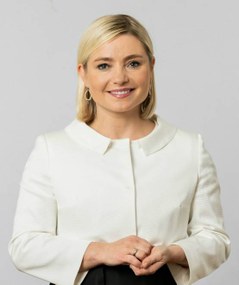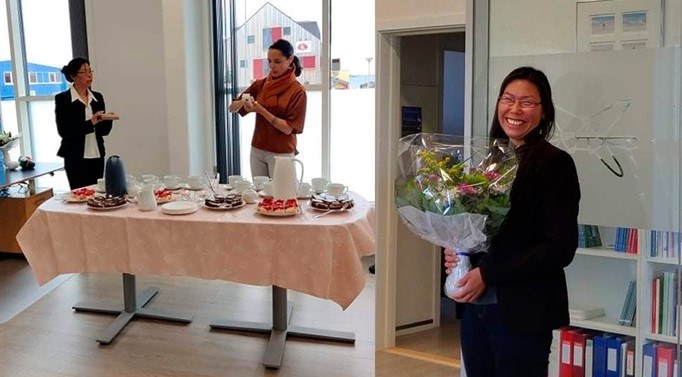Small languages need big language's help to reach IT giants
Languages that are not used in the digital world will not survive. That is the brutal message which formed the basis for the Nordic language meeting – a two days long conference on the latest development in language technology.
Earlier this year, Iceland’s Minister of Culture Lilja D. Alfreðsdóttir wrote to Tim Cook, CEO of tech giant Apple, asking him to help maintain Icelandic as a language by including it in the voice, text and language collection in their operative systems.
“Few countries in the world can beat Icelanders when it comes to internet cover or how many gadgets they own,” she pointed out.
But the problem is that these gadgets do not speak Icelandic.
“So we worry about what will happen to our language. It has remained nearly unchanged for a thousand years and is at the core of our nation’s culture and identity,” she wrote to Tim Cook.
 Lilja D. Alfreðsdóttir is one of the most popular ministers in the Icelandic government. She has earlier criticised Disney when they launched a TV channel in Iceland because there were too few films and programmes that had subtitles or were dubbed in Icelandic.
Lilja D. Alfreðsdóttir is one of the most popular ministers in the Icelandic government. She has earlier criticised Disney when they launched a TV channel in Iceland because there were too few films and programmes that had subtitles or were dubbed in Icelandic.
Icelandic authorities have asked researchers, entrepreneurs and private companies to cooperate in various projects to try to develop language technology that can be used in smartphones and other tools so that these can also use Icelandic.
This goes beyond being able to ask questions in Icelandic to digital assistants like Siri and Alexa. We already use a range of different language technology without a second thought:
- Spellcheck programs
- Translation programs from speech to text and the other way around
- Simultaneous translation programs for both speech and text, useful for conferences and more
Icelandic is a large language compared to Sami or Greenlandic, and it has a rich literature.
If you want to get an idea of how small Greenlandic is in the digital world, one can compare the English and Greenlandic versions of Wikipedia. The English Wikipedia has more than 54 million pages, while the Greenlandic consist of 8 222.
Microsoft Word does support Kalaallisut – the Greenlandic word for the language – in its basic spellcheck, but it is not supported as a screen language, in text to language, speech recognition or handwriting.
On my iPhone, I can't find Greenlandic as a language at all.
 Beatrine Heilmann became the leader of the language secretariat of Greenland, Oqaasileriffik in July. Photo: Naalakkersuisut
Beatrine Heilmann became the leader of the language secretariat of Greenland, Oqaasileriffik in July. Photo: Naalakkersuisut
Beatrine Heilmann, leader of The language secretariat Oqaasileriffik, describes Greenlandic as “a super-vital minority language” in the world.
She is the first-ever Greenlandic language technologist and is in charge of the development of a computer program that can translate Greenlandic to Danish and English.
The work with Greenlandic language technology in Oqaasileriffik began in 2005 and the first Greenlandic spellcheck was launched one year later. This was done in close cooperation with The University of Tromsø in Norway.
“This did not include all the words, but it showed that it was possible to develop language technology tools also for a polysynthetic language like Greenlandic,” she says.
Simply put, in a polysynthetic language words change shape according to the grammatical context. Where other languages use an entire sentence, these languages bake everything into one long word.
Fifteen years later, many things have been created; a corpus of Greenlandic texts and words, terminology databases, programs for converting written text to speech and a Greenlandic-Danish-Greenlandic translation program.
“15 to 20 years ago, very few Greenlanders had internet access. Today most do, but in other languages from Greenlandic,” says Beatrine Heilmann.
Greenlanders have gone from being very isolated to be able to access all the world’s news and entertainment via the internet. But this has also made their language more vulnerable. Just like in Iceland, there is very little children’s programming in Greenlandic for instance.
“The most important thing we can do is to adapt Greenlandic to the digital world.”
Three challenges
There are three main challenges to this, says Heilmann:
- The language situation in Greenland
- A lack of open-source data
- Access to the big IT companies
Greenland’s language situation is in need of improvement. Many Greenlandic texts contain many errors, – both spelling errors, but also grammatical errors – which offer a lot of challenges for working with them in the field of language technology.
In order to be able to handle the areas that require the production and development of technological resources based on the Greenlandic language, the children in primary and lower secondary school and the young people in the educational institutions must be prepared to be robust enough in the Greenlandic language and technology. Action is needed across society to remedy this – in education, professional life and in the media. It is also difficult to develop digital language tools because few text collections are open source.
“The licenses are too expensive for us to be able to afford them. We can dream about publishing the Greenlandic-English dictionary containing 100,000 words, but it would cost too much,” says Beatrine Heilmann.
A lot of the language technology work that is being done is wasted when it cannot be used in word-processing programs like Microsoft Office.
“We fought for two years to try to get a spellcheck included in Office, but we did not have enough competence and were not given access to the necessary source code. When we write to the big IT companies we either get no response or we get a standard answer which simply proves that nobody can be bothered to understand what we are actually asking.
“We therefore hope that both the large and small Nordic languages can come together and demand the opportunity to use our languages in the digital tools that we all use,” says Beatrine Heilmann.
- Two Greenlandic women
-
holding up a child in a Nuuk street in Greenland (above).
- Facts about Greenlandic
-
Greenlandic, or Kalaallisut as the Greenlanders call their language, is spoken by 50,000 people and is also understood more or less by 40,000 Inuits in Canada. There are three dialects – West Greenlandic, which is the largest, and Northern and Eastern Greenlandic. UNESCO considers Western Greenlandic to be in a “vulnerable” state. The largest linguistic difference is found between Western and Eastern Greenlandic (which is spoken by only 5,000 people).
- The Nordic language meeting
-
was this year organised by The Language Council of Norway and ran online on 26 and 27 August. The theme was language technology.
- Declaration on a Nordic Language Policy
-
According to the Nordic language declaration:
"Nordic language policy has a responsibility to world society to see that in particular the languages that are not national languages anywhere continue to live and develop, and that all minority languages can continue to exist. It is important that sign language also be granted a strong position."
 Follow us on Facebook
Follow us on Facebook
